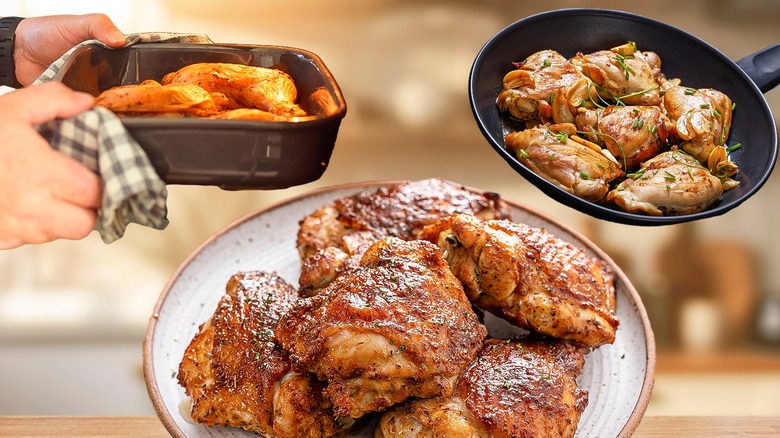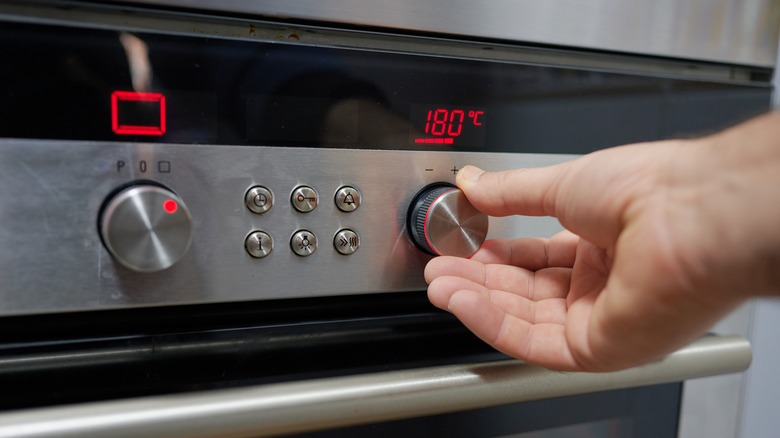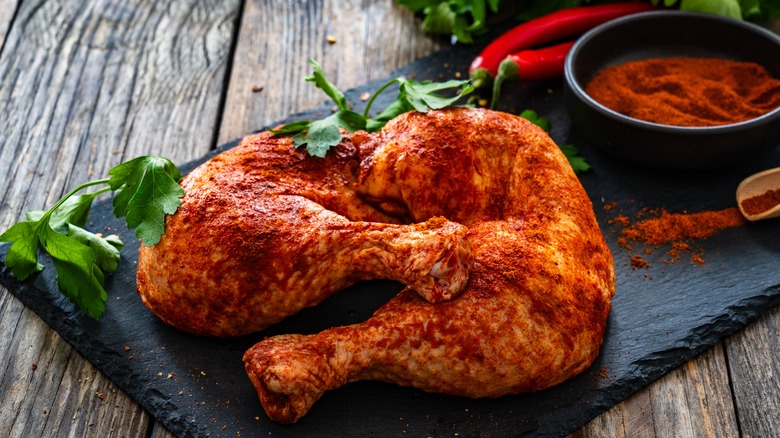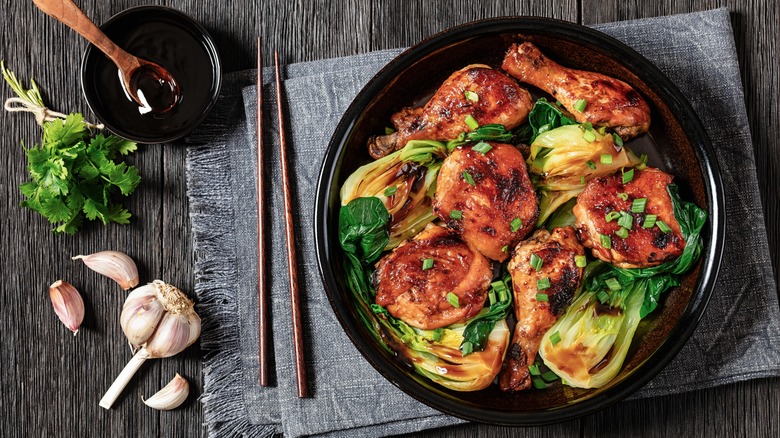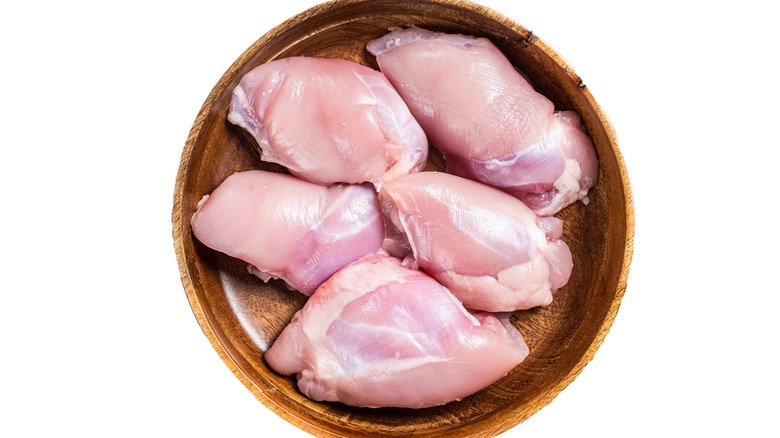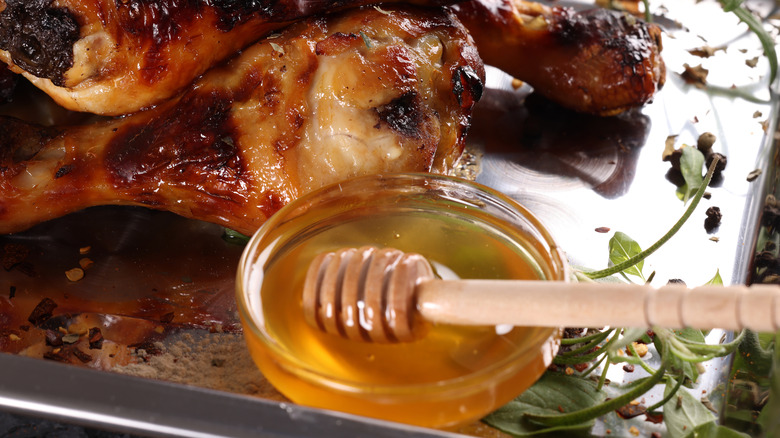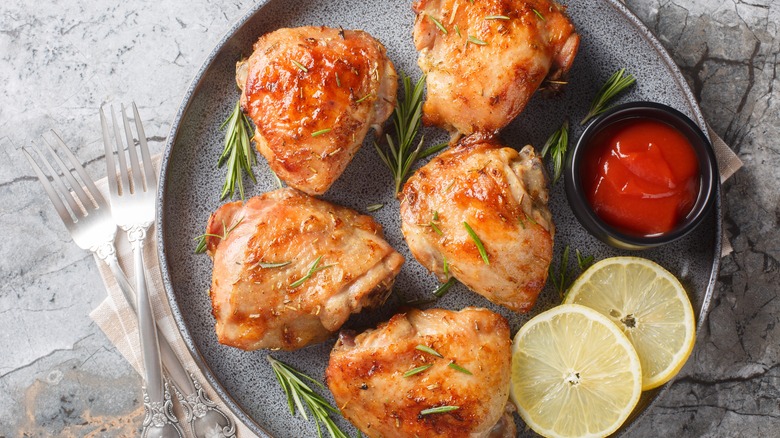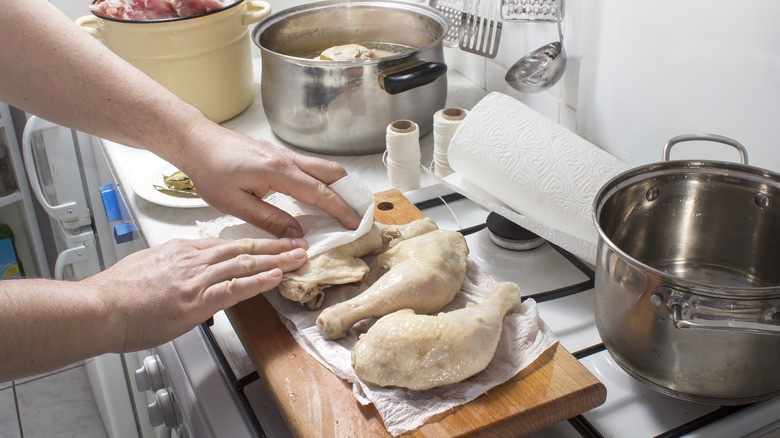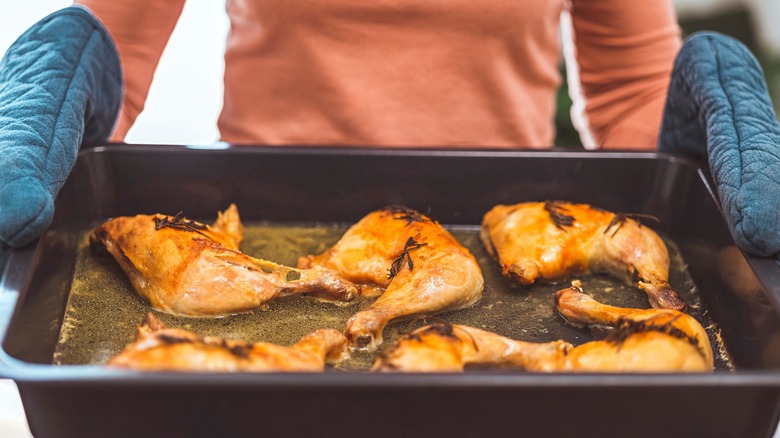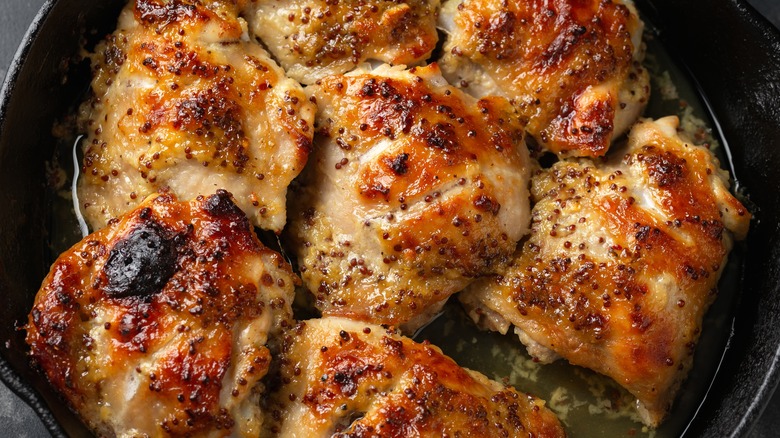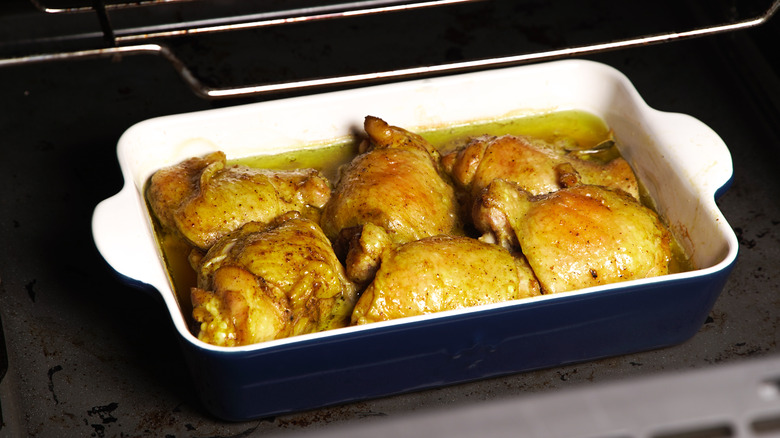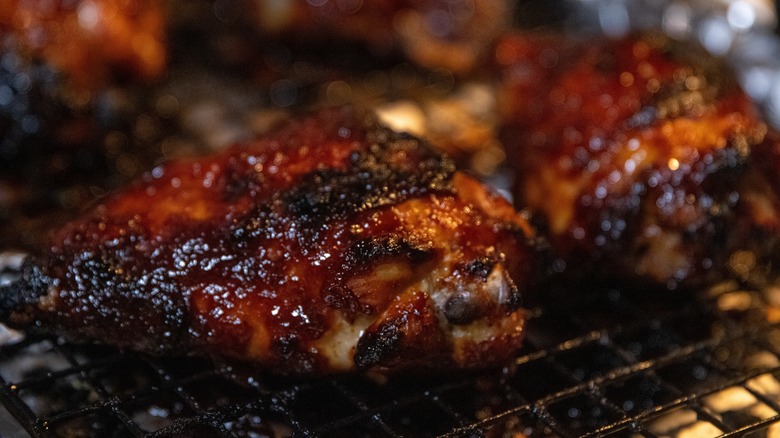12 Mistakes Keeping You From Perfect Chicken Thighs
Chicken thighs are often unfairly in the shadow of chicken breasts when it comes to whipping up an appetizing midweek meal, but they can actually be tastier and more tender than their more popular counterpart. If you are new to cooking thighs, however, there are a few common pitfalls that may prevent you from having delicious, juicy meat to serve. From under-seasoning to over-marinating, numerous little things can scupper your attempts.
To help you identify the mistakes you may be making when cooking chicken thighs and learn how to avoid them in the future, Chowhound spoke to three experts who shared their most helpful tips. Kenny Gilbert is an award-winning chef and entrepreneur who is best known for his appearance on "Top Chef;" Dennis Littley has 40 years of experience as a fine dining chef and is now a recipe expert at Ask Chef Dennis; and Marye Audet-White is a recipe developer, a four-time best selling author, and the CEO of Restless Chipotle. Between them, they have decades of experience in the kitchen and a wealth of knowledge on how to cook chicken thighs perfectly. Here's where you are going wrong.
Choosing the incorrect cooking temperature
To get perfectly cooked chicken thighs, the first step is to know how long to cook them and at what temperature. Sticking them in the oven and hoping for the best is not going to be good enough, and could result in meat that is dangerously undercooked, or overcooked and tough. Kenny Gilbert admits that advising what temperature to cook chicken thighs is not as simple of a question as it seems because it depends on your cooking method. For frying, he recommends 325 degrees Fahrenheit, while roasting should be around 400 degrees Fahrenheit. If you poach the thighs, he says to stick to 210 degrees Fahrenheit.
Both Dennis Littley and Marye Audet-White agree with the oven-roasting temperature. "For chicken thighs, the sweet spot is 375-400 degrees Fahrenheit," Littley said. "Also, undercooking or overcooking are common pitfalls. Thighs are forgiving but still need attention to timing."
The key when oven-roasting thighs is to get the right balance between cooking the meat beautifully and making the skin deliciously crunchy. "I usually set my oven to 400 degrees Fahrenheit for chicken thighs," Audet-White said. "It's hot enough to crisp the skin and cook them through without drying them out." Getting the temperature right is a crucial step in the search for a tasty and succulent dish, so consider the cooking method and temperature that will be needed before you start.
Not being bold enough with your seasoning
When it comes to seasoning your chicken thighs, you may be used to adding a pinch of salt and a crack of black pepper and sliding them into the oven. But in doing so, you are missing the perfect opportunity to pack them full of flavor, which they can soak up as they cook.
"Thighs can handle bold seasoning, but home cooks often don't season deeply enough," Dennis Littley said. "Salt should go on early to let it penetrate." Even when salting, there is no need to settle for the ordinary. Flavored salts taste amazing and are widely available, making it easy to infuse your meat with chili, herbs, or citrus flavors.
Marye Audet-White also encourages using more daring flavors than just the basic seasonings. "I like to use a mix of salt, pepper, garlic powder, and smoked paprika," she said. If you have any pre-mixed seasonings, chicken thighs are a great way to use them, as the blend of flavors will be absorbed beautifully by the meat. Slather your preferred rub across the top and bottom of the meat to make sure every bite is equally delicious. If you left the skin on your chicken thighs, make sure to season under it as well. "People forget to season under the skin for skin-on thighs," Littley said. "It's a key step to infusing flavor."
Failing to adapt your seasoning depending on the style of dish
When deciding how to season your chicken thighs, you have to keep in mind what the final dish is going to taste like, and adapt your seasoning appropriately. Kenny Gilbert points out that the herbs, spices, and coatings you use will depend on the style of food that you are planning to serve.
"[For] Chinese stir-fry, you would slice the thighs thin and toss in cornstarch, then blanch in boiling salted water for 1-2 minutes, remove, and then shock in ice water," he said. "Then you would stir fry [them] in a hot wok with oil or deep fry at 350-375 degrees Fahrenheit." Chinese cuisine includes seasonings such as soy sauce, ginger, and garlic, meaning you would want to incorporate these flavors into your chicken.
If you're planning to keep your chicken dish more classically American and fry the thighs, be sure to season the crumb coating well too. "If I was going to fry, buttermilk with spices, mustard, and gluten-free soy sauce is the cheat code for a great seasoned fried chicken thigh," Gilbert said.
Missing out on flavor by using skinless, boneless thighs
If you have a habit of buying skinless, boneless chicken thighs, you probably appreciate that they cook more quickly and are easy to prepare, but you need to be aware of what you are missing out on too. Both the bone and skin have a significant role to play in the flavor and texture of the meat, and removing them can drastically affect the result.
"Skin-on, bone-in is my go-to," Dennis Littley said. "The bone adds flavor and helps maintain moisture, while the skin can get perfectly crispy if you cook it right. Skinless, boneless thighs have their place in quicker dishes or stir-fries, but they tend to lack that depth you get with the whole thigh." Kenny Gilbert agrees, saying, "I love the skin, whether I fry, grill, bake, sauté, [or] roast."
Marye Audet-White also recommends choosing skin-on and bone-in thighs, especially when roasting or grilling. "The bone keeps the meat juicy, and the skin adds so much flavor," she said. Just remember, bone-in chicken thighs will take longer to cook than boneless, so adjust your cooking time accordingly.
Creating a burnt flavor with sugary marinades
Every keen home cook knows that the key to fantastic meat is to add a marinade and let it infuse to benefit both the flavor and texture. You may have slathered your chicken thighs in honey, molasses, or maple syrup for a nice honey soy marinated baked chicken thigh recipe, then thrown them in the oven to do their thing, only to pull them out later to find a charred mess.
Sugary marinades are a great idea in theory, but they can burn before your chicken is fully cooked, according to Dennis Littley. Sugar begins to burn at around 350 degrees Fahrenheit, meaning if your oven is on full, you are likely to have issues.
Marye Audet-White is mindful of showing restraint with sweet marinades. "A hack I swear by is adding a little sugar or honey to help with caramelization, but not too much, or it'll burn," she said. If you really love the idea of adding honey or other sugar-based ingredients to your chicken thigh recipes, consider adding them closer to the end of the cook, where they can impart their sweet flavors without becoming over-caramelized.
Leaving acidic marinades on for too long
Marinating is the key to mouthwatering chicken thighs. "Marinating will ... enhance the flavor of the chicken," he said. "If I was going to smoke or grill, I like to marinate overnight, using a light neutral oil and lots of spices, herbs, and garlic."
However, if you are using acidic ingredients in your marinade, which are known for adding lots of flavor and helping to tenderize the meat, you need to keep an eye on the clock. "I keep my marinades simple — olive oil, lemon juice, and herbs," Marye Audet-White said. "But be careful. Marinate for no more than four hours if you're using citrus or vinegar. Longer than that, and the meat can turn mushy. And remember, marinating doesn't make them cook faster, but it'll make them juicier."
If you are planning to leave your chicken thighs in the marinade overnight, consider omitting the acids to prevent the meat's texture from being affected too much. "Instead, focus on salt and fat in your marinade to amplify flavor and tenderness," Dennis Littley said.
Forgetting to pat the skin dry before searing
Assuming you have chosen to leave the skin on your chicken thighs, the next step is to make sure you get ultra crispy chicken skin, because soggy chicken skin is impressing no one. One simple step you can do at the start of the cook can help you achieve that golden crispness. "It's all about technique," Dennis Littley said. "Start by patting the skin dry, then sear the thighs skin-side down in a hot pan before transferring them to the oven. This method gives you a head start on crisping the skin without drying out the meat. Another trick is to finish off with a quick broil to crisp the skin if needed."
Marye Audet-White has a similar technique but includes an unusual ingredient in her chicken preparation. "Here's my trick: pat the skin dry, then rub it with a little baking powder before seasoning," she said. "It sounds odd, but it helps pull out moisture and makes the skin crisp up beautifully in the oven."
Drying the skin before you season will also prevent the salt and spices from forming clumps, meaning the flavor will be uniform across the meat. Once the skin is dry and seasoned, it's time to apply the heat. "Start with the thighs skin-side down in a hot skillet to render the fat before finishing them in the oven," Audet-White said. "Air fryers are another great option for crispy skin and juicy meat in less time!"
Relying on oven cooking as the only method
There is no doubt that oven-roasting chicken thighs is a convenient and easy way to cook them, and should result in evenly-cooked meat. But it is not the only option, and if you are willing to explore some alternatives, you may find it changes the flavor and texture of the meat.
If you can sous vide your chicken thighs, Kenny Gilbert recommends it as an alternative to oven cooking. "Marinate your chicken thighs in a ziplock bag overnight," he said. "Sous vide at 143.3 degrees Fahrenheit for one hour. Remove from the bag and grill for a few minutes on each side. You will have a very flavorful, juicy piece of chicken."
If the sous vide method is not for you, there are still alternatives to the reliable oven, though they may need more of a watchful eye from you. "Oven-roasting is fantastic for even cooking, but I wouldn't call it the only best method," Dennis Littley said. "Grilling or pan-searing can work just as well if done right. What's crucial is controlling the heat to avoid drying out the meat while achieving a nice, crispy exterior."
Crowding the pan
In your eagerness to cook for a large group of people, you may find yourself squeezing as many chicken thighs into the roasting tray as you can fit, but this is not a good idea. Marye Audet-White cautions against crowding them in the pan, as they need space to cook. If the chicken thighs are pressed up against each other, they will not be able to crisp up properly, leading to soggy skin and less-than-appetizing meat.
If the chicken has plenty of space in the pan, the juice released during cooking can evaporate easily. But if there is no space around the outside of each chicken thigh, the moisture can build up, meaning your meat will end up steamed rather than beautifully crisp and golden.
To prevent this, you may need to cook your chicken thighs in batches. If you have a big enough oven, you may still be able to cook them all at the same time, splitting them between two trays. For pan frying, you will need to cook half of them, then keep them warm in the oven while you cook the other half. It may be a bit more hassle, but it will be worth it for that gorgeous golden skin.
Removing the chicken thighs from the oven before the internal temperature is correct
If you are well-versed in cooking chicken breast, you may be feeling confident that you can do a great job of thighs without the need for a meat thermometer. However, dark thigh meat takes longer to cook properly than lean breast meat, so pulling them from the oven too soon could result in dangerous, underdone meat.
"You want to aim for an internal temperature of 175 degrees Fahrenheit," Dennis Littley said. "Many people pull chicken thighs too early, around 165 degrees Fahrenheit, which works for breasts but leaves thighs undercooked and rubbery. They need that extra time to break down the connective tissue and get juicy."
The great thing about chicken thighs is that they are much more forgiving if they go above the optimal temperature of 175 degrees Fahrenheit. Whereas chicken breasts overcook and become dry just a few degrees over their optimal, thighs will be beautifully soft and tender even 20 degrees over.
Serving the chicken thighs without resting them
Once your chicken thighs are perfectly cooked, you will be desperate to plate them up straight away and start tucking in. But patience in this case will pay off, as resting the thighs before you serve them will improve their texture significantly.
As it cooks, the moisture from the meat heads for the center, leaving the outside of the chicken dry. Leaving the meat to rest allows the juices to return to where they belong, creating the juicy texture that you are aiming for. "Let the chicken rest for about five minutes before serving to keep all those tasty juices inside!" Marye Audet-White said.
And if you were worried, know that resting the chicken doesn't have to mean letting it go cold. You can cover your tray of thighs with some loosely wrapped kitchen foil to help keep the heat in, meaning the meat can be both juicy and warm. Because the thighs are a bit more forgiving than chicken breast, you shouldn't need to worry about them becoming overcooked during this time.
Failing to use a wire rack
If you're choosing to leave the skin on your chicken thighs — and you definitely should — it is crucial that you do what you can to make that skin as crispy as possible. In a similar way to the tip of not overcrowding the baking pan, it is important to ensure that as much of the chicken is exposed to the heat as possible if you want a perfect golden color.
Placing the chicken thighs directly onto a baking sheet or roasting tray means that the juices they release as they cook could cause the meat to steam instead of roast. Marye Audet-White has a great tip to prevent this from happening. "I love using a wire rack over a baking sheet when roasting thighs," she said. "It lets the air circulate, so the skin gets extra crispy."
This method allows the fat to drip away from the chicken as it cooks, and allows the meat and skin to roast perfectly. However, if you want to avoid the nightmare of an oven covered in chicken fat, be sure to put something under the rack to catch the drips!
